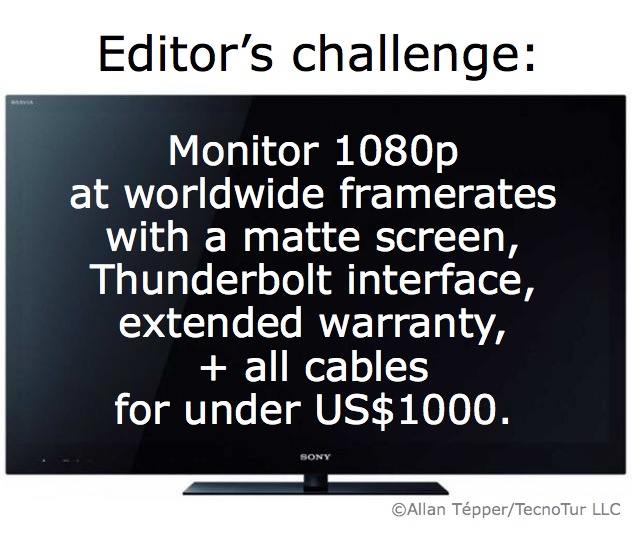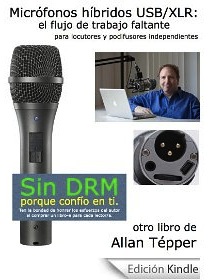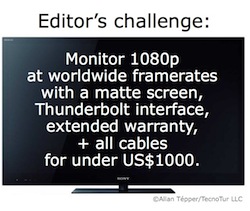
When Miami-based PRODU.com set out to choose the key components for a new video editing system, they already knew that they’d be purchasing a 2012 iMac and a Thunderbolt drive. However, since most HDTV sets sold in the U.S. are unfortunately segregated, what was more challenging was to achieve a good 1080p video monitoring solution at worldwide framerates and with a matte display, all for under US$1000 including an extended warranty, professional Thunderbolt a/v interface, and cables. The monitor they picked is unusual for the United States. Learn about which monitor, which interface, and why ahead in this article.
In this article
- General criteria for picking a 1080p monitoring system when you can’t afford a pro model
- Segregated HDTV sets and why PRODU.com chose this particular monitor
- Monitoring equipment chosen by PRODU.com (including the Thunderbolt a/v interface)
- Why purchase a third-party warranty for the KDL–40BX420E in the U.S.
- Use and compatibility of the KDL–40BX420E in the U.S.
- Physical size of the KDL–40BX420E
- Why did PRODU.com choose the UltraStudio Mini Monitor?
- SIDEBAR: Why I write framerate as a compound word
- What I would change in the KDL–40BX420E to create a prosumer version
- Related monitoring articles
General criteria for picking a 1080p monitoring system when you can’t afford a pro model
Even though most professional video editors would love to have an HP DreamColor or other pro monitor (see related articles at the end of this one), some simply cannot afford it. In that case, the next best thing is often to choose a consumer 1080p monitor or HDTV set which is guaranteed to accept all standard worldwide framerates (i.e. 23.976p, 24.000p, 25p, 29.97p, 50i/p, and 59.94i/p), 1:1 pixel-by-pixel monitoring (without overscan), a matte screen (for those of us who prefer it that way), and an appropriate output interface between the computer and the monitor.
Segregated HDTV sets and why PRODU.com chose the Sony KDL–40BX420E
As I covered back in this 2008 article, many consumer HDTV sets currently sold in the United States are unfortunately segregated, which means that they reject signals at 25p, 25PsF, 50i, or 50p. When this is done, it is often by design in an attempt to avoid grey marketing. Some accept 23.976p and or 24.000p but don’t display a proper cadence. In order to have worldwide compatibility, PRODU.com needed a monitoring solution that would cover any standard framerate used worldwide, as long as it came in within budget and met other requirements. PRODU.com also knew that not all HD monitors that accept 23.976p and/or 24.000p handle it with proper cadence. Fortunately, in his review of the segregated USA version of this monitor (KDL–40BX420, without the “E” suffix), CNET senior editor David Katzmaier stated:
The inexpensive Sony KDL-BX420 series evinced good performance for an entry-level non-LED-TV, with deep-enough black levels and accurate color in mid-bright areas. It also, surprisingly for a 60Hz TV, handled 1080p/24 cadence properly, and its matte screen is a boon in bright rooms. Its styling is clean and its remote is among the best in its class…
David must have been referring to a 23.976 cadence (or to both 23.976 and 24.000 cadences) since I tested both 23.976p and 24.000p sources, and they both looked proper via the HDMI input. It is not clear whether the KDL-BX420 and KDL-BX420E play 23.976p at 47.952 fps by repeating each frame (as 24 fps films are seen in traditional movie theaters at 48 fps via a double shutter) or whether it is tripling the original 23.976p and displaying at 71.928 fps, but whatever it is doing, it looks good and proper via the HDMI input. If desired, you may read David’s entire review here. Just realize that David reviewed the segregated USA version.
Monitoring equipment chosen by PRODU.com (including the Thunderbolt a/v interface)
Here you’ll see which video monitoring equipment PRODU.com chose and its approximate street price as of publication time of this article:
- Sony KDL–40BX420E (with world framerate capability) US$590
- Blackmagic UltraStudio Mini Monitor US$145 (which I covered here and here)
- Apple 2 meter Thunderbolt cable (recently reduced in price) US$39
- HDMI cable US$10
- Third-party 2-year U.S. warranty US$50 (See details ahead.)
Total US$834 (not including shipping or possible State sales tax)
On page 2 of this article
- Why purchase a third-party warranty for the KDL–40BX420E in the U.S.
- Use and compatibility of the KDL–40BX420E in the U.S.
- Physical size of the KDL–40BX420E
- Why did PRODU.com choose the UltraStudio Mini Monitor?
- SIDEBAR: Why I write framerate as a compound word
- What I would change in the KDL–40BX420E to create a prosumer version
- Related monitoring articles
Click here for page 2 of this article…
…
Why purchase a third-party warranty for the KDL–40BX420E in the U.S.
Especially if you plan to use it in the United States, the purchase of a third-party warranty for the KDL–40BX420E is highly advisable since Sony U.S. does not officially sell or handle this model. The ±US$50 third-party 2-year U.S. warranty covers that.
Use and compatibility of the KDL–40BX420E in the U.S.
Although according to Sony’s published specs, the KDL–40BX420E requires a 220–240 voltage source, the supplier where PRODU.com purchased it assures that it really works fine with the full range of 110–240 volts, so no external transformer is required. In fact, inside the box was a plug adapter for use with a standard U.S. 110–120-volt outlet. The digital internal tuner is for DVB (not ATSC), so it won’t work for over-the-air DTV in the USA, but that is not the purpose in an editing system, and it will certainly work when connected to a set top box in the U.S. (AppleTV, Blu-ray player, cable box, DVD player, GoogleTV, Roku, WDTV, etc.). The KDLR–40BX420E’s analog internal tuner is for PAL B/D/G/I/K/L (Argentineans, Paraguayans, and Uruguayans will notice the lack of PAL N, while Brazilians will notice the lack of PAL M), but it doesn’t matter for the same reasons. Via the HDMI and analog video inputs, the KDL–40BX420E can receive NTSC and NTSC-derived signals, as well as PAL and PAL-derived signals. However, 23.976p and 24.000p work only via the HDMI input.
Physical size of the KDL–40BX420E
Many editors may prefer a video monitor that is closer to a 24-inch diagonal size as opposed to 40-inch like the KDL–40BX420E. However, PRODU.com actually prefers the larger 40-inch size of the KDL–40BX420E since they plan to mount it further away from the editor, on the wall behind the editor’s desk.
Why did PRODU.com choose the UltraStudio Mini Monitor?
PRODU.com was only interested in monitoring (output), not capture (input), since all of their new acquisition is tapeless. Even their older footage was DV25 and HDV, both of which can be captured via IEEE–1394 (Firewire) and therefore doesn’t require a pro interface for native capture. If PRODU.com ever needed to capture those formats, they could simply acquire an IEEE–1394>Thunderbolt adapter. PRODU.com chose the Blackmagic UltraStudio Mini Monitor both because of its low cost, compatibility with all standard worldwide framerates, and possible future use with DaVinci Resolve, which exclusively works with Blackmagic interfaces. (See my recent article UltraStudio Mini Monitor works with DaVinci Resolve, but should you use it for serious grading?)
Why I write framerate as a compound word
Since a reader wrote in to question my spelling of the word framerate, I am adding this sidebar to clarify my position. To my knowledge, the word framerate doesn't (yet) appear in any dictionary. However, the purpose of any dictionary (in any language) is to document both the spelling and meaning of existing words. The purpose of a dictionary has never been to prevent the creation of new words. That’s why all good dictionaries are constantly being updated to document the birth of new words, which are born in use, not in the dictionary. Many of the new words which are born every year are compound words. Here are a few examples of some compound words:
- cockpit (born from cock + pit, 1580–90)
- corkscrew (born from the combination of cork + screw, 1805–15)
- flashlight (born from the combination flash + light, 1885-90)
- microphone (born from the combination of micro + phone, 1875–80)
- windshield (born from the combination of wind + shield, 1900–1905)
Like all compound words, they were born in use out of logic, and then they were added to the dictionary. I am not the first to write framerate as a compound word as you will see if you do a Google search for “framerate” including the quotation marks. As I check right now, there are 9,310,000 uses of it as a compound word, as opposed to 22,200,000 as separate words. There are more uses as separate words than as a compound word because with 9,310,000 uses to date, it is obviously fairly new, but certainly quite popular already. As I stated at the beginning of this sidebar, the purpose of any dictionary (in any language) is to document both the spelling and meaning of existing words. The purpose of a dictionary has never been to prevent the creation of new words.
What I would change in the KDL–40BX420E to create a prosumer version
Standby for an upcoming article where I suggest a prosumer version to Sony, similar to what often happens with Sony consumer cameras which often become the basis for prosumer ones.
Upcoming articles
To make sure you continue to see my upcoming articles, sign up to my mailing list here.
Related monitoring articles
- Allan Tépper's: HP DreamColor Mac connectivity & functionality: update 2012.1
- Allan Tépper's: HP DreamColor Mac connectivity & functionality: update 2012.2
- Allan Tépper's: Does Premiere CS5 achieve the “impossible dream” for critical evaluation monitoring?
- Allan Tépper's: Why should I care if my monitor shows ITU Rec.709?
- Allan Tépper's: Who is the ITU, and why should I care?
- Allan Tépper's: How to connect your HD evaluation monitor to your editing system properly: Let me count the ways!
- Allan Tépper's review: DreamColor from HP: an ideal tool for critical image evaluation
- Patrick Inhofer's review: HP's DreamColor: A PVM CRT Replacement?
- Allan Tépper's: DreamColor direct interfaces
- Allan Tépper's: DreamColor converter boxes for non-compliant systems
- Allan Tépper's: Matrox's original MXO crashes the Direct DreamColor interface party from January 10, 2010
- Art Adam's: GEEK OUT: The Non-Technical Technical Guide to Sony OLED Monitors from March 6, 2012
- Allan Tépper's Bandito Brothers use multiple HP DreamColors + Adobe Premiere for Act of Valor from March 9, 2012
- Allan Tépper's Blackmagic: We're ready to remove the Band-Aid!
- Allan Tépper's HP DreamColor versus its closest alternative
My latest ebook
I have recently published an ebook in two languages. The format is Kindle, but even if you don’t have a Kindle device, you can read Kindle books on many other devices using a free Kindle app. That includes iPad, iPhone, Android phones, Android tablets, Mac computers, Windows computers, some Blackberry phones and Windows 7 phones.
In English:  In English, it is currently available in the following Amazon stores, depending upon your region:
In English, it is currently available in the following Amazon stores, depending upon your region:
- At Amazon.com (for all of the Americas and the Republic of India, and for all worldwide gift purchases)
- Amazon.ca (Canada)
- Amazon.co.jp (Japan)
- Amazon.co.uk (United Kingdom)
- Amazon.de (Germany)
- Amazon.es (Spain, pero a lo mejor lo prefieres en castellano, a continuación)
- Amazon.fr (France)
- Amazon.it (Italy)
If you’re going to buy a Kindle book as a gift, you must do so via the Pan-American Amazon store (the first one listed above), regardless of where you live or where the recipient lives.
En castellano:  En castellano, está disponible actualmente en las siguientes tiendas Amazon, según tu región:
En castellano, está disponible actualmente en las siguientes tiendas Amazon, según tu región:
- Amazon.com (todas las Américas la República de la India… y todas las compras de regalo mundialmente)
- Amazon.co.jp (Japón)
- Amazon.co.uk (Reino Unido)
- Amazon.de (Alemania)
- Amazon.es (España)
- Amazon.fr (Francia)
- Amazon.it (Italia)
Si vas a comprar un libro Kindle como regalo, debes hacerlo vía la tienda panamericana de Amazon (la primera de la lista) sin importar donde vivas tú o donde viva la persona que recibirá el regalo.
Allan Tépper’s books, consulting, articles, seminars & audio programs
Contact Allan Tépper for consulting, or find a full listing of his books, articles and upcoming seminars and webinars at AllanTepper.com. Listen to his TecnoTur program, which is now available both in Castilian (aka “Spanish”) and in English, free of charge. Search for TecnoTur in iTunes or visit TecnoTur.us for more information.
Disclosure, to comply with the FTC’s rules
No manufacturer is specifically paying Allan Tépper or TecnoTur LLC to write this article or the mentioned books. Some of the other manufacturers listed above have contracted Tépper and/or TecnoTur LLC to carry out consulting and/or translations/localizations/transcreations. Many of the manufacturers listed above have sent Allan Tépper review units. Allan Tépper has done consulting for PRODU.com for the past couple of decades. So far, none of the manufacturers listed above is/are sponsors of the TecnoTur programs, although they are welcome to do so, and some are, may be (or may have been) sponsors of ProVideo Coalition magazine. Some links to third parties listed in this article and/or on this web page may indirectly benefit TecnoTur LLC via affiliate programs.
Copyright and use of this article
The articles contained in the TecnoTur channel in ProVideo Coalition magazine are copyright Allan Tépper/TecnoTur LLC, except where otherwise attributed. Unauthorized use is prohibited without prior approval, except for short quotes which link back to this page, which are encouraged!

Filmtools
Filmmakers go-to destination for pre-production, production & post production equipment!
Shop Now













